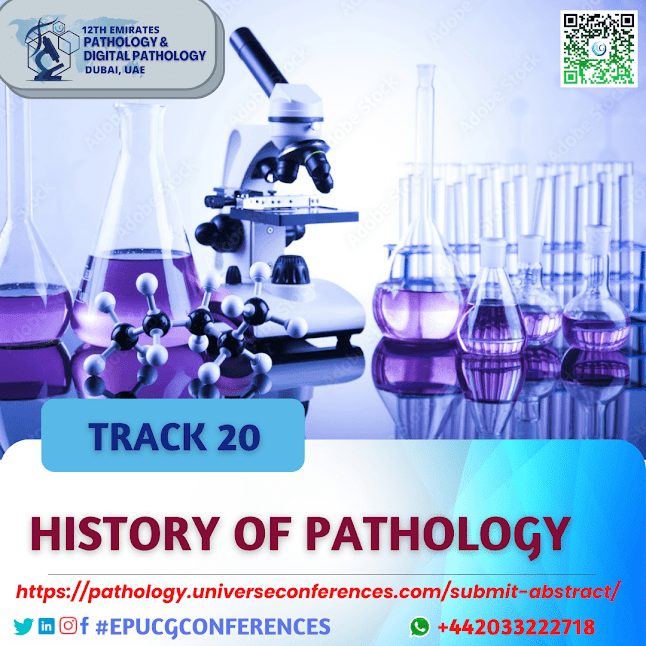Call for Paper Track: 20 History of Pathology
Call for Paper Track: 20 History of Pathology
12th Emirates
Pathology & Digital Pathology Conference on December 21-23, 2022 in Dubai,
UAE
What is pathology?
We must understand what causes disease and how to prevent it
if we want to live a long and healthy life. Pathology is the study of illness,
including how it develops, how it spreads, and where it comes from. Pathology
also includes the study of pharmaceuticals that could be used to treat or
prevent diseases.
A pathologist is a person who examines diseases and works in
the field of pathology. They use electronics and high-tech tools in a
laboratory setting. Many pathologists from all around the world have stopped
the spread of numerous illnesses, including polio.
General pathology, anatomical pathology, clinical pathology,
chemical pathology, genetics, hematology, immunology, and microbiology are
some of the divisions of pathology.
12th Emirates Pathology & Digital Pathology Event on December 21-23, 2022 in Dubai, UAE
History of Pathology
Egypt
Before 1500 BC, the first known study of sickness was conducted in Egypt. Ancient scrolls cover a brief history of anatomy and the illnesses that this society was dealing with at the time. Many scientists attribute their expertise to the numerous embalmings they carried out, which is the process of protecting corpses from deterioration. Although they gathered this information, it's thought that they lacked a strategy for using it to treat specific illnesses like gallstones or abscesses.
Greece
Ancient Greeks started studying the human condition and using what they
learned to improve people's health around 300 BCE. This is the true origin of
pathology. The word "pathology" actually derives from the Greek words
pathos, which means "suffering," and logia, which means
"logic."
which means
'study of.
12th Emirates Pathology & Digital Pathology Summit
on December 21-23, 2022 in Dubai, UAE
Galen, a Greek physician who was born in what is now Turkey, made additional discoveries in the realm of pathology through dissection.Galen dissected animals and documented their physiology, despite the fact that this was not a common practise at the time. This aided in his comprehension of the importance of the body's many systems as well as how inflammation may impact them.
12th Emirates Pathology & Digital Pathology Congress
on December 21-23, 2022 in Dubai, UAE
Origins of pathology
The earliest use of the scientific method in the realm of medicine was
in the early understanding of illness origins, which emerged in the Middle East
during the Islamic Golden Age and in Western Europe during the Italian
Renaissance.
Origins of microscopic pathology
The father of microscopic pathology is widely regarded as Rudolf Virchow (1821–1902). Virchow was one of the first well known doctors to stress the study of disease manifestations that were only observable at the cellular level, even though the compound microscope had been created around 150 years before. One of the first experimental pathologists was Julius Cohnheim (1839–1844), a pupil of Virchow, who used histology methods and experimental manipulations to explore inflammation. The frozen section process was also invented by Cohnheim; pathologists nowadays frequently use a variation of this method to render diagnoses and provide other clinical information intraoperatively.
12th Emirates Pathology & Digital Pathology Exhibition
on December 21-23, 2022 in Dubai, UAE
Important Information:
Conference Name: 12th Emirates Pathology &
Digital Pathology Utilitarian Conference
Short
Name: 12EPUCG2022
Dates December
21-23, 2022
Venue: Dubai, UAE
Scientific Program: It will only
include plenary speakers, keynote speakers, panel discussions and presentations
in parallel sessions.
Audience: Global Leaders,
Industrialists, Business Delegates, Students, Entrepreneurs, Executives
Email: pathology@universeconferences.com
Visit: https://pathology.universeconferences.com/
Pathology Experts:https://pathology.universeconferences.com/pathology-experts/
Call for Papers: https://pathology.universeconferences.com/submit-abstract/
Register here: https://pathology.universeconferences.com/registration/
Call Us: +12073070027
WhatsApp Us:
+4420332227110
Pathology Medical Conferences, Histopathology
meeting, Immunology
conference, clinical
Pathology webinars, Plant
Pathology Conferences, CME
Pathology Conferences, Pathology
Congresses, World
Pathology Congress, Clinical
Pathology, Laboratory
Medicine Conference, Digital Pathology exhibition
Reference pathology and digital pathology
UCGconferences press releases and blogs
Medium: https://medium.com/@traviis.stork/call-for-paper-track-3-breast-pathology-837328eaad1
Global health : https://globalhealthtrainingcentre.tghn.org/community/blogs/your_posts/
Linked In: https://www.linkedin.com/pulse/call-paper-track-3-breast-pathology-dr-travis-stork-1f
Tumbler: https://www.tumblr.com/blog/view/digitalpathologyucgconferences/689005131446059008?source=share
#MolecularPathology #SLPath #pathologist
#surgery #microbiology #anatomy #biochemistry #anatomy #medstudent #medstudent
#pathologists #histology #medicine #pharmacology #medschool #biology #medico
#dermpath #microscope #clinicalresearch #medicalstudent #medicaleducation
#Covid19 #omicron #bpath #meeting #Breastcancer #Breastpath #Cencer #cancerawareness
#chemotherapy #cancerdemama #health #breastcancerwarrior #cancerfighter
#breastpathology #breastcancerfighter #breastcancersupport




Comments
Post a Comment